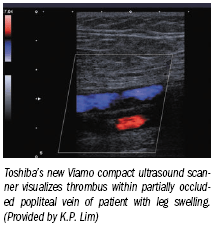Philips, Toshiba enter hand-carried ultrasound market
Philips and Toshiba have joined ultrasound vendors looking to cash in on physicians' love of good things that come in small packages.
Philips and Toshiba have joined ultrasound vendors looking to cash in on physicians' love of good things that come in small packages. Both have made their names in ultrasound as providers of high-performance cart-based systems. Now each has unveiled a high-performance general-purpose scanner that can be carried rather than rolled.
Toshiba's new Viamo, commercialized in April, shares the core imaging engine that drives the company's cart-based flagship, Aplio XG. It runs high-end capabilities, including pulse subtraction tissue harmonic imaging. And it can support advanced applications, including those in radiology. But the new product can also handle jobs in the emergency room, intensive care unit, and vascular labs, as well as support interventions, such as breast biopsies, surgical procedures, and anesthesiology, according to company executives.
Like Toshiba, Philips has leveraged technological developments at its premium end, porting many of the technologies found in its high-performance scanners and their transducers to the hand-carried general-purpose CX50 CompactXtreme. The new portable product, set for global release in July, is configured as a shared services version of the cardiology system that Philips launched under the same name last summer.
Buyers will pay a premium for the mobility found in Philips' and Toshiba's new high-end compacts. The systems ballpark between $75,000 and $100,000, depending on their
configurations.
The CX50 and Viamo are about the size of a thick laptop. Both sport 15-inch LCD screens. CX50's screen pops up like a screen on a laptop. Viamo's LCD swivels 270° into position above the body of the scanner. Each can be carried to the scanning location but has the option of being rolled there on a lightweight, maneuverable cart.
Although Viamo has its own complement of specialty transducers, specially designed adapters allow the portable scanner to connect with transducers designed for other Toshiba systems, such as those for Aplio and Xario. Philips' CX50 relies mostly on specially made transducers, but engineers have fashioned an adapter that allows its use with a transesophageal transducer already in the Philips lineup. The company is looking into making more adapters for other transducers.

Dr. Adrian K.P. Lim, a consultant radiologist and senior lecturer at Imp-erial College London, Hammersmith and Charing Cross Hospitals Campus in the U.K., described Viamo's gray-scale and Doppler images as “impressive” in diagnostic and interventional cases. High-end technologies leveraged in the hand-carried system deliver images that have reduced clutter and greater uniformity, he said.
As part of luminary testing before the unit was commercially released, Lim spent several days testing Viamo, then returned it.
“I would have liked to have kept it,” Lim said. “It does basic imaging very well but also has high-end functions.”
The difference between such high-performance systems and Philips' cart-based product is not in their performance, according to Philips executive Jim Walchenbach, but in how they are used. The marketing manager for Philips ultrasound says the CX50 is to a high-performance cart-based system as a smart phone is to a desktop computer.
“Today, on a smart phone, you can do just about anything you can do on your home computer, but you wouldn't want to create a PowerPoint on your smart phone,” Walchenbach said. “With compact ultrasound, you take premium performance to the patient, but you don't necessarily get the same workflow that you would want to have on a daily basis all day long.”
The Reading Room: Racial and Ethnic Minorities, Cancer Screenings, and COVID-19
November 3rd 2020In this podcast episode, Dr. Shalom Kalnicki, from Montefiore and Albert Einstein College of Medicine, discusses the disparities minority patients face with cancer screenings and what can be done to increase access during the pandemic.
What New Research Reveals About Novice Use of AI-Guided Cardiac Ultrasound
April 4th 2025In a study recently presented at the American College of Cardiology (ACC) conference, researchers found that novice use of AI-guided cardiac ultrasound after an AI-enabled electrocardiogram increased the positive predictive value for reduced left ventricular ejection fraction (LVEF) or aortic valve stenosis by 33 percent.